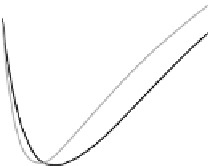Geoscience Reference
In-Depth Information
a
b
c
2.5
2.5
〈ε〉
.09
2
2
.08
1.5
1.5
.07
1
1
B
e
B
2
.06
0.5
0.5
0.5
1
1.5
2
2.5
0.5
1
1.5
2
2.5
0
.2
.4
.6
.8
γ
Fig. 8.8
Scatter plots of the true diagonal elements of
B
g
(
vertical axis
) versus their approxima-
tions by LH0 (
a
)andLH1(
b
) algorithms. The actual values are multiplied by 10
3
. Near-boundary
points are excluded.
Right
: Diagonal approximation errors as a function of
for the
B
g
(
black
)
3
givenby(
8.50
)
and
B
2
(
gray
) models.
Dashed line
shows the value of
Figure
8.8
demonstrates the accuracy of LH0 and LH1 methods in such setting:
the LH0 method provides an accuracy of 9 % which is further improved to 6 % by
the LH1 scheme. The major improvement occurs in the regions where points with
highly anisotropic
neighbor isotropic points and reduce the diagonal elements
in the latter. The effect is reflected by the negative bias of the scatter plot at high
values of
d
0
, which reaches its maximum of 0.0237 in the points with isotropic
(Fig.
8.8
a).
Figure
8.8
c shows the dependence of approximation error
"
on the value of
3
for both correlation models. The best approximation is obtained at
3
D
0:26
,a
value somewhat lower than suggested by the heuristic formula (
3
D
5=18
D
0:28
,
dashed line). Similarly to the 2d case, the optimal value of
3
.
B
2
/
D
0:21
is less
than
, which is in agreement with the more rapid off-diagonal decay of the
B
2
matrix elements.
In general, it appears that the relationship (
8.50
) provides a reasonable guidance
to the estimation of the smoothing parameter in the LH1 method. For the
B
g
model,
the operator acting on
d
g
3
.
B
g
/
can be implemented by either reducing the number of
“time steps” in integration of the diffusion equation
1=2
-fold
reduction of the decorrelation radius. For the
B
2
model only the second option is
applicable: it also reduces the number of iterations required for computing the action
of the
B
2
due to the decrease of the condition number.
1
times, or by
8.4
Summary and Discussion
BEC modeling with the diffusion operator is an efficient and flexible tool for
evaluating matrix-vector products of large dimension which emerge in minimization
algorithms of variational data assimilation. In this chapter, we discussed two
major issues associated with this type of models: construction of a positive-definte
smoothing operator
B
as a rational function of
D
and the estimation of diag
B
.




































































































































































































































































































































































































































































































































































































































































































































































































































































































































































































































































































































































































































































































































































































































































































































































































































































































































































































































































































































































































































































































































































































































































































































































































































































































































































































































































































































































































































































































































































































































































































































































































































































































































































































































































































































































































































































































































































































































































































































































































































































































































































































































































































































































































































































































































































































































































































































































































































































































































































































































































































































































































































































































































































Search WWH ::

Custom Search